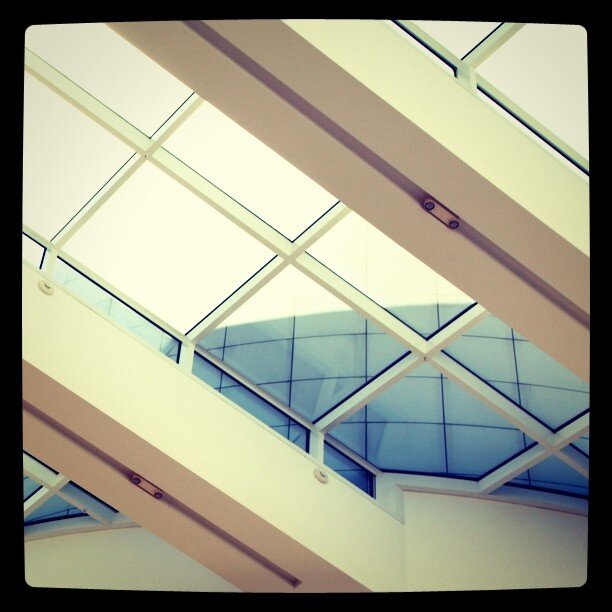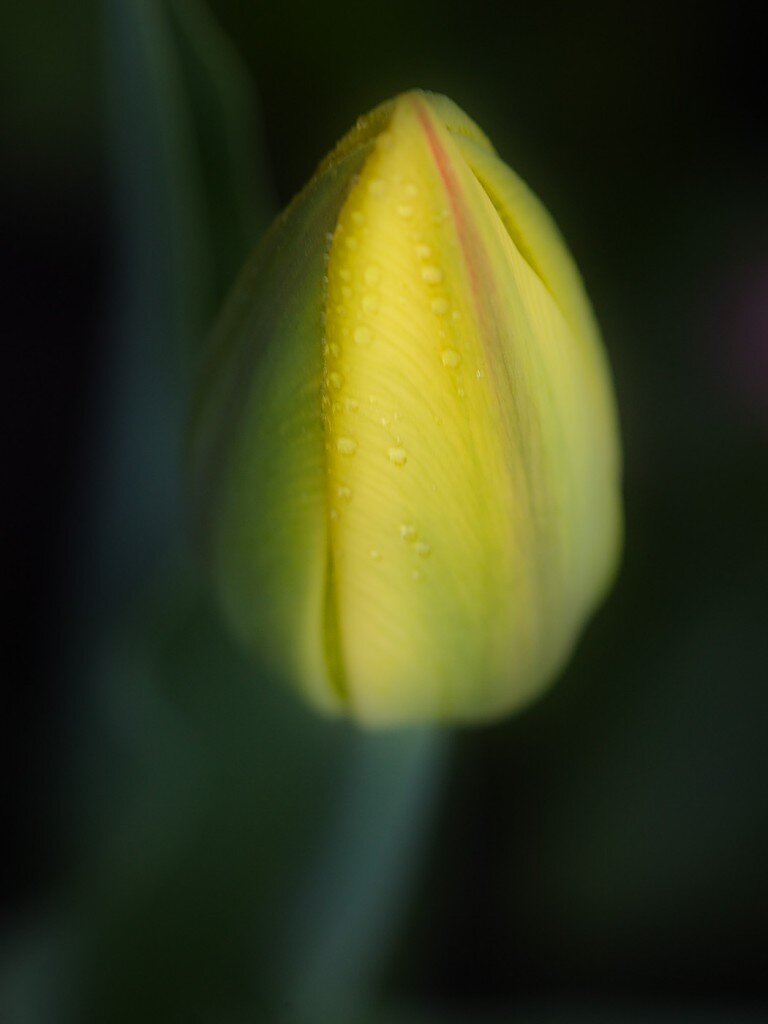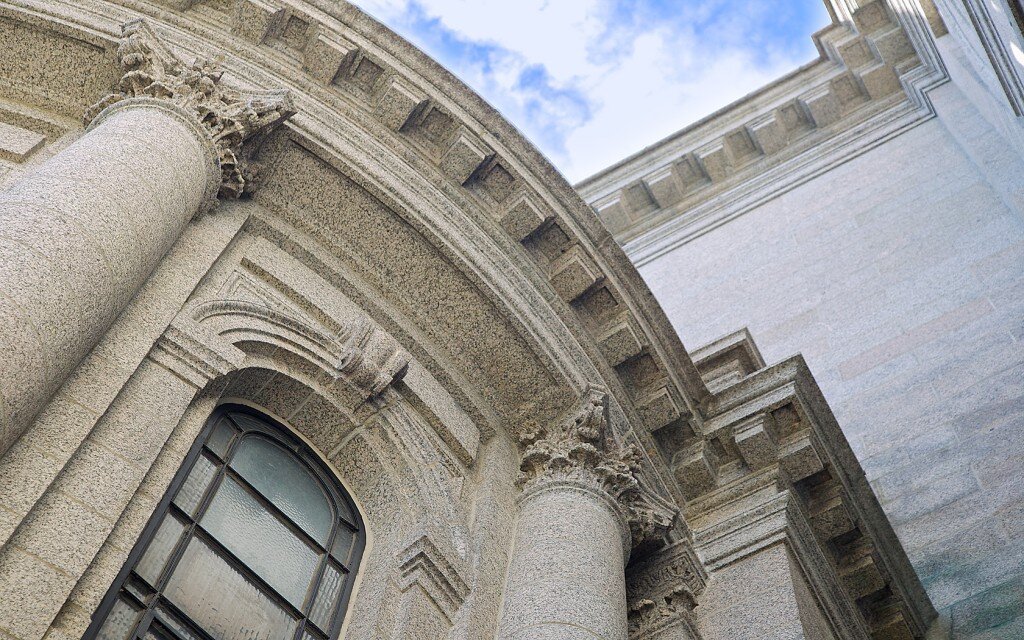 This is another tulip shot, this time in my neighbor's yard. I love the beautiful deep purple of these flowers.Here's the first one I posted a few days ago.And here's the other one.
This is another tulip shot, this time in my neighbor's yard. I love the beautiful deep purple of these flowers.Here's the first one I posted a few days ago.And here's the other one.
Almost
On the Green
 He stood on the tee of the par 3 hole and felt a slight breeze coming from behind. With alacrity and confidence, he quickly made his club selection. (I think it was a 3 iron.) And then with an athleticism and tempo that only a person who plays golf once or twice a year could have, he stroked the ball. He couldn't see the path of the white projectile because it was getting dark. He also needs new bifocals. But one of the younger golfers playing with him said, "I think it's close."And it was.The photo, incidentally, is the first time in two years that a guest photographer has had a photo posted on "A Photo A Day." The photographer is my friend Jack, who told me that he was thinking of the Rule of Thirds when he took this shot.I'm proud of Jack and I'm proud of the golfer for almost making a hole-in-one.
He stood on the tee of the par 3 hole and felt a slight breeze coming from behind. With alacrity and confidence, he quickly made his club selection. (I think it was a 3 iron.) And then with an athleticism and tempo that only a person who plays golf once or twice a year could have, he stroked the ball. He couldn't see the path of the white projectile because it was getting dark. He also needs new bifocals. But one of the younger golfers playing with him said, "I think it's close."And it was.The photo, incidentally, is the first time in two years that a guest photographer has had a photo posted on "A Photo A Day." The photographer is my friend Jack, who told me that he was thinking of the Rule of Thirds when he took this shot.I'm proud of Jack and I'm proud of the golfer for almost making a hole-in-one.
Angels In the Architecture
 This is a shot I took at the Getty Center. Are there really angels here? Perhaps if you look closely, though for today's title I was thinking of the Paul Simon lyric that contains that phrase:
This is a shot I took at the Getty Center. Are there really angels here? Perhaps if you look closely, though for today's title I was thinking of the Paul Simon lyric that contains that phrase:
He looks around, aroundHe sees angels in the architectureSpinning in infinityHe says Amen! and Hallelujah!
I see many things when I look at the photo. I may even see angels. . . .
The Old Refrigerator
Special Potion?
From the Second Floor
Craquelure (iPhoneography - Instagram)
Altered Reality
 I have said that because the human brain doesn't see frames around things, photographers manipulate reality simply by framing a subject and clicking the shutter. I have also said that as a rule, I don't like to use software (such as Photoshop) to further manipulate reality.But guess what? I have been learning new things in Photoshop and this tulip photo and the one from yesterday are results of fairly heavy "altered reality." What have I done? It involves layers and blending options.But forget about that. Instead, I hope you like the dark, mysterious look and the deep tones of the reds and greens in these tulips, which I found growing between two buildings on my morning walk in St. Paul last Sunday.
I have said that because the human brain doesn't see frames around things, photographers manipulate reality simply by framing a subject and clicking the shutter. I have also said that as a rule, I don't like to use software (such as Photoshop) to further manipulate reality.But guess what? I have been learning new things in Photoshop and this tulip photo and the one from yesterday are results of fairly heavy "altered reality." What have I done? It involves layers and blending options.But forget about that. Instead, I hope you like the dark, mysterious look and the deep tones of the reds and greens in these tulips, which I found growing between two buildings on my morning walk in St. Paul last Sunday.
About To Burst
St. Paul Cathedral - Another View
St. Paul Cathedral
 I wasn't planning to photograph the St. Paul Cathedral yesterday morning. Instead, I went off to photograph the capital building in St. Paul, Minnesota. Unfortunately, there was scaffolding all over the dome. So I took photos of the nearby Cathedral.Some of you are wondering if this photo is "real" or whether I put in a fake sky (or a fake cathedral!)? This is real, though it is actually two photos - my camera doesn't have the ability to expose a bright sky and the north side of a building and make it look this this. In photography talk, it doesn't have the "dynamic range" to do this.Thus, I took two photos, exposing one for the sky and the other for the church and then combined them into one picture. This is called HDR photography. It's a neat trick that helps the camera see things closer to how the human eye does. The human eye has an incredible dynamic range.
I wasn't planning to photograph the St. Paul Cathedral yesterday morning. Instead, I went off to photograph the capital building in St. Paul, Minnesota. Unfortunately, there was scaffolding all over the dome. So I took photos of the nearby Cathedral.Some of you are wondering if this photo is "real" or whether I put in a fake sky (or a fake cathedral!)? This is real, though it is actually two photos - my camera doesn't have the ability to expose a bright sky and the north side of a building and make it look this this. In photography talk, it doesn't have the "dynamic range" to do this.Thus, I took two photos, exposing one for the sky and the other for the church and then combined them into one picture. This is called HDR photography. It's a neat trick that helps the camera see things closer to how the human eye does. The human eye has an incredible dynamic range.







